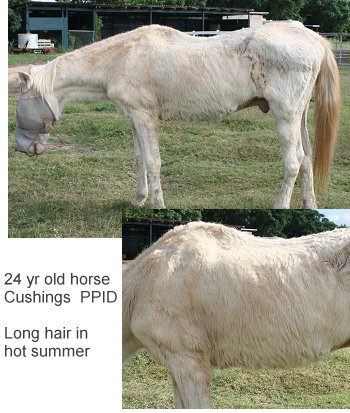
A healthy horse’s coat changes in different times of the year. The summer coat is usually short and slick and shiny. It dries quickly and is easy to brush. Winter coat is generally comprised of two types of hair: one short and thick and warm, the other longer to provide an air space insulation against cold temperatures. It tends to hold moisture if the horse gets soaked or sweats during exercise.
A horse that is in poor health may have a dull, coarse hair coat. Poor coat condition could be caused by parasitic ailments, Cushings Disease, thyroid imbalance and other horse diseases.
Cushings Disease is caused by a dysfunction of the pituitary gland: an enlarged and overactive pituitary gland normally kept in check by inhibitory dopamine from the hypothalamus goes into overdrive and over-produces a certain pituitary hormone. It is most common in older horses 18 – 23 years old (about 20% of geriatric horses develop Cushings). Also known as Pituitary Pars Intermedia Dysfunction or PPID, it is sometimes associated with Insulin Resistance (although not always) and can be confused with Equine Metabolic Syndrome. (Horses with EMS always have insulin resistance while horses with PPID may or may not have it. Since researchers now believe the laminitis associated with these two conditions stems from faulty insulin metabolism, horses suspected of having either EMS or PPID should be tested for insulin resistance.)
Generally, Cushing’s most pronounced symptom noticed first by the owner is a growth of long, curly hair and a failure to shed or delayed shedding of winter hair into sleek summer coat. This is accompanied by a decrease in athleticism, wasting of muscles or pot belly, lethargy, abnormal sweating, crested neck (fatty deposits particularly on the crest of the neck), and in advanced cases, neurological deficits and blindness.
Veterinarians can perform tests to diagnose both diseases, and a test for insulin resistance should also be performed on a Cushings horse to decide exactly how to manage his diet.
According to Dr. Lydia F. Gray, DVM, MA SmartPak Staff Veterinarian and Medical Director, “it is important to have some grasp of the underlying problem in EMS, PPID with insulin resistance, and PPID without insulin resistance so that the appropriate nutrition, management, and prescription medication (if necessary) can be started. For example, while oxidative stress is a factor in all three conditions—and for which antioxidants like Vitamin E are recommended—only horses with faulty insulin metabolism really need the sugars and starches in their diets limited. So a horse with PPID that has normal insulin function can and should have access to high-quality hay, pasture, and other forage sources to help maintain gut health and good weight.”
A horse with insulin resistance (sugar and insulin metabolism problems) should avoid eating traditional grains, treats or pasture because these can be high in sugars and starches. A horse with Cushings AND insulin resistance should eat low-sugar/high-fiber feed made especially for senior horses with added fat calories if needed.
Cushings horses often have a compromised immune system and need to be monitored frequently and cared for with attention to maintenance details such as diet, dental care and vaccinations.
Please note that this advice is neither veterinary nor prescriptive in nature but offered only as an introduction to this topic.
We need your help. We certainly don’ t know everything. Please share your expertise and experiences. Comment on what is already written or Suggest a Category and Educate us about it. Grow Horse-Pros.com©